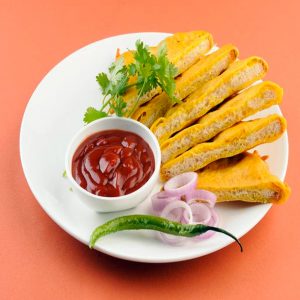Bread de Pakore (Fried Bread Fritters)
By popular demand, here is a reprint of Mama’s Bread De Pakore recipe, which is just the kind of tasty, hot fritter that you need for the winter months to take your mind off the bitter cold and rain outside. It is reprinted with some additional information and directions.
To most people, pakoras (or pakore) are an inexpensive fried snack that combines the flavor of a vegetable, fish or chicken with a spicy batter and is eaten with some chutney, and served mostly as an appetizer. In many Indian cities, it is eaten as a snack, often from a hawker stand on the street corner or from the neighborhood halwai (pastry cook), coming hot, straight from the boiling cauldron.
It is the satisfying, carbohydrate-rich garbanzo (or chickpea) flour or besan used in the batter that makes pakore so irresistible. Besan also has higher protein content than other flours and is used in a variety of other food and snack preparations.
In North India, where the staple food is wheat flour and many types of rotis (breads), paranthas (stuffed flatbread) and naans are made, it is only natural for this to be combined in some way with besan. There is even a type of special bread called missi roti that is made with a mixture of atta (wheat flour) and besan.
Add in another favorite carbohydrate of Indians – double roti or bread. Until the Portuguese, French, Dutch and English came to the Subcontinent, people were not familiar with the European style of bread. From the Portuguese word “pao” (for bread) came the term Pav Bhaji, a Marathi dish that was invented in the 1850’s for the textile workers coming off their midnight shift. And the from the two pieces of bread stuffed with vegetables or meat to make a sandwich came the term “double roti”, a term universally used in the Indian Subcontinent to refer to any loaf of bread.
So for those who prefer the crispiness of a pakora, but the fluffiness of a slice of double roti, what better way than to fry the bread coated in besan? This is especially a hit with young kids who eat it like salted pancakes for breakfast, or even for dinner, dipping it in some tomato ketchup! Hmmm! Delicious!!
Ingredients:
• 1.5 cups besan (chickpea flour)
• Water – enough to make running paste
• 4 slices bread – preferably white, sandwich bread
• 2 cup vegetable oil for deep frying
• Spices to taste: namak (salt), mirch (red pepper)
Directions:
1. Mix in namak and mirch into 1.5 cups of besan and water till it becomes a soft, running paste.
2. Take a slice of sandwich bread and cut it in half diagonally. Some people even prefer to use a whole slice of bread.
3. Heat the oil in a karahi (wok). Throw in a small dab of batter to make sure the oil is very hot. Take a piece of bread, dip it into the batter then release it into the hot oil. Repeat with the other pieces of bread, a few at a time depending on the size of the karahi.
4. When one side is slightly brown, turn it over using a sieved spatula and turn over a few times to make sure both sides are cooked. Be careful that they do not become dark brown. Take them out and place on a paper towel to absorb the extra oil.
5. Bread pakoras are best when served hot with some tomato ketchup.
MAMA’S TIP OF THE WEEK: KEEP A POHNNA OR TWO HANDY WHILE COOKING
Traditional Indian cooking requires a lot of time in front of an open flame or hot stove, especially when making fried foods or those nice, hot rotis and paranthas. In the way that I learnt as a girl growing up in our family’s ancestral towns of Jhung and Lyallpur, we always had to touch hot foods, pots, tavas (hotplates) or chullas (earthen stoves) and sometimes even put our forearms inside tandoors (earthen ovens).
We learnt quickly that a pohnna – basically just a short piece of soft cloth folded several time – was our best guardian against getting burnt. We used it to fluff up rotis, move hot pots and paste atta (flour) cakes against the tandoor walls. These days, cooks use spatulas to stir foods and flip rotis, but in the best of Punjabi traditions, a pohnna gives you more control when making rotis and using multiple stoves at the same time, without burning your fingers.

Shakuntla Malhotra is a skilled cook of Punjabi dishes made in the old-fashioned style that she learnt as a young woman in her ancestral home in Lyallpur, India (since renamed Faisalabad) before it became part of Pakistan after the Partition in 1947. People have often admired her cooking for its simplicity and taste that comes with each mouthful. Even in her late-eighties, she continues to cook daily and agreed to share her delectable Punjabi vegetarian recipes for future generations.

